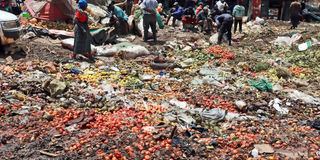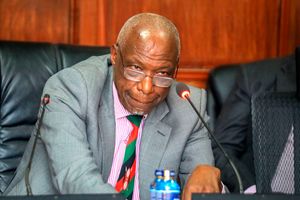Premium
As Covid-19 hogs the limelight, other diseases have been killing for months

Traders at a filthy section of Muthurwa Market expose themselves to diseases. Dennis Onsongo | Nation Media Group
As Kenya focuses its resources and attention to Covid-19, cholera, measles and little-known Kalaazar have been wreaking havoc.
The diseases have killed at least 45 people in parts of Eastern, Central and Northern Eastern in the past three months.
More than 25 people died of cholera and over 1,200 were hospitalised in North Eastern as the counties shift their efforts to the coronavirus pandemic. Although the World Health Organization (WHO) weekly says only 13 people have died of cholera, reports from healthcare workers in Garissa, Marsabit, Murang’a, Turkana and Wajir indicate that the number could be two or three times higher than what has been reported to the global health governing body.
Turkana, which still has an active cholera outbreak, has had the fourth wave of the diarrhoeal disease since the beginning of the year. The outbreak is also active in Garissa.
Lower vaccination
A total of 323 cases of measles and one death were reported and confirmed in nine counties among them West Pokot, Tana River, Garissa, Kilifi and Wajir. Leishmaniasis, a neglected tropical disease also known as Kalaazar, has been reported in Baringo, Garissa, Kitui and Marsabit counties, with more than 14 people hospitalised.
Benjamin Tsofa, a PhD in health systems and policy from Kenya Medical Research Institute-Wellcome Trust programme in Kilifi, said the measles deaths particularly show a problem in the health system. Measles, a highly infectious disease preventable by vaccination, has also claimed the lives of four children in Kenya.
“Measles deaths show a health system that is not able to immunise, which is the most basic service it is supposed to give and which is simpler than treating,” Dr Tsofa told HealthyNation.
Dr Tsofa said lockdowns interfered with movement and this kept many caregivers from hospitals.
Monthly reports of global immunisation by Unicef showed 85 per cent of countries reported that they had lower vaccination in May than in January-February. The decline was highest (89 per cent) in African countries.
Systemic neglect
The Unicef report listed the reasons for lower immunisation rates: “ almost half (48 per cent) indicated that users are concerned about the risk of exposure to Covid-19 if they go for vaccination, and one third (33 per cent) indicated that the main factor related to limited public transport, lockdown and physical distancing policies”.
Save for Murang’a, the affected counties have similarities: they are arid; they have fragile health systems that have suffered systemic neglect since independence; they are attacked by counties that are exacerbated by poverty and shunned by the health system. West Pokot has experienced bouts of measles since October 2019, and Covid-19 worsened the community engagements for measles.
Andrew Mulwa, the county health minister of Makueni and the chair of the intergovernmental caucus for health executive committee members, said while Covid-19 has forced counties to strengthen their health systems, attention has been drawn away from the diseases.
He added that immunisation was already a challenge in arid counties due to the nomadic nature of those who live there.


